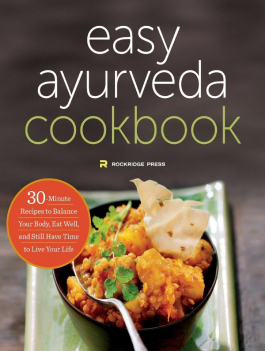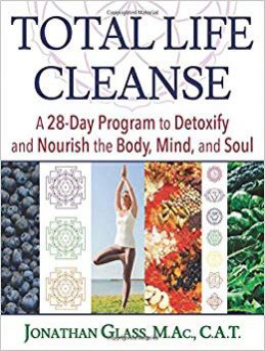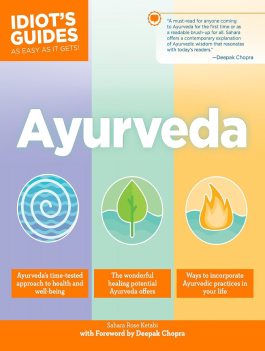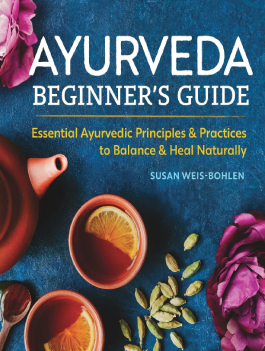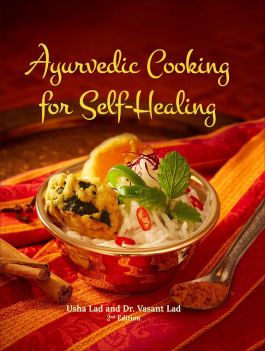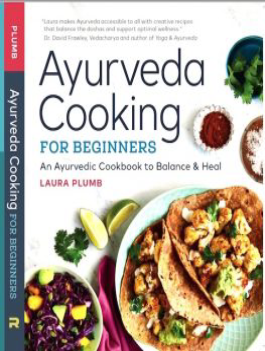Ayurveda
The Science of Life.
Introduction to Ayurveda
Ayurveda is a system of medicine with historical roots in the Indian subcontinent, originated more than 3,000 years ago. The term Ayurveda is derived from the Sanskrit words Ayur (life) and Veda (wisdom/science or knowledge). Thus, Ayurveda translates to knowledge of life.
Globalized and modernized practices derived from Ayurveda traditions are a type of alternative medicine. In countries beyond India, Ayurvedic therapies and practices have been integrated in general wellness applications and in some cases in medical use.
Based on the idea that disease is due to an imbalance or stress in a person’s consciousness, Ayurveda encourages certain lifestyle interventions and natural therapies to regain a balance between the body, mind, spirit, and the environment.
In the United States, it’s considered a form of complementary and alternative medicine (CAM)
Understanding Ayurveda and Your Life Energies (Vata, Pitta, Kapha)
The concepts of universal interconnectedness, the body’s constitution (prakriti), and life forces (doshas) are the primary basis of Ayurvedic medicine.
Ayurveda believes every person is made of five basic elements found in the universe: space, air, fire, water, and earth.
These combine in the human body to form three life forces or energies, called doshas. They control how your body works. They are Vata dosha, Pitta dosha and Kapha dosha
Everyone inherits a unique mix of the three doshas. But one is usually stronger than the others. Each one controls a different body function. It’s believed that your chances of getting sick — and the health issues you develop — are linked to the balance of your doshas.
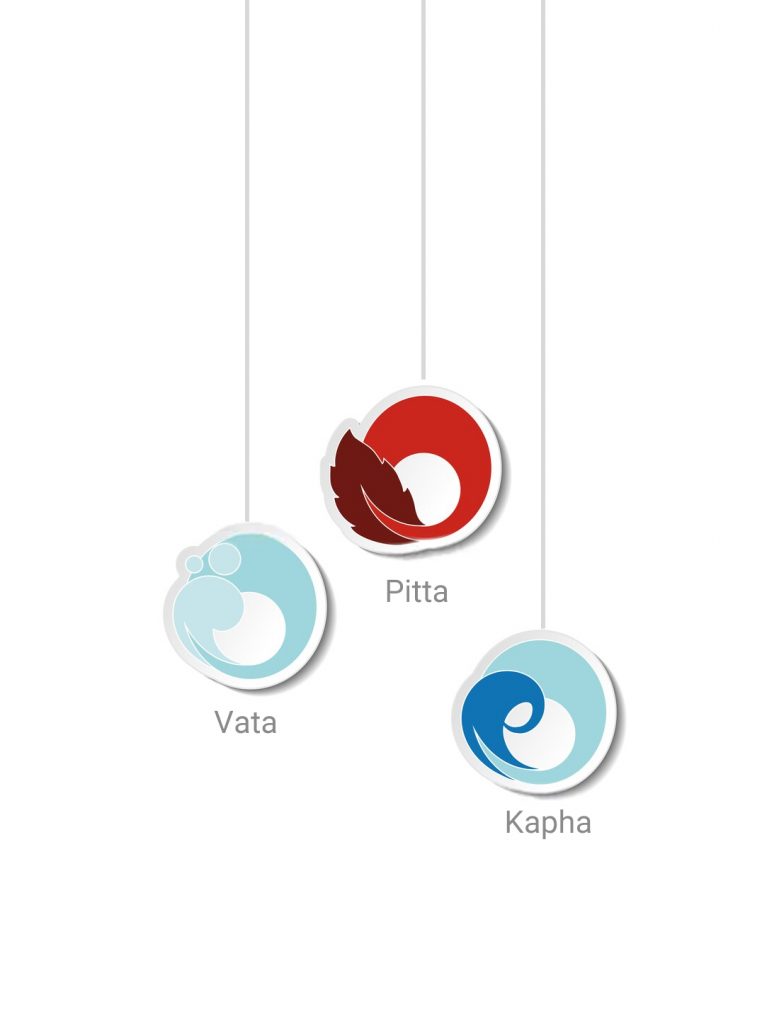

ATTRIBUTES OF THE THREE DOSHAS
Vata
- Dry
- Light
- Cold
- Rough
- Subtle
- Mobile
- Clear
Pitta
- Oily
- Sharp (penetrating)
- Hot
- Light
- Mobile
- Liquid
Kapha
- Heavy
- Slow
- Cold
- Oily
- Slimy (smooth)
- Dense
- Soft
- Static (stable)
- Cloudy (sticky)

Vata dosha
It controls movement and is responsible for basic body processes such as breathing, cell division, and circulation. Vata body areas are the large intestine, pelvis, bones, skin, ears, and thighs. People with vata as their main dosha are believed to be quick-thinking, thin, and fast, and be susceptible to anxiety, dry skin, and constipation.
Pitta dosha
It is thought to control hormones and the digestive system. Pitta body areas are the small intestines, stomach, sweat glands, skin, blood, and eyes. People with pitta as their primary dosha are thought to have a fiery personality, oily skin, and be susceptible to heart disease, stomach ulcers, inflammation, heartburn, and arthritis.

Kapha dosha
Responsible for strength, immunity, and growth. Kapha body areas are the chest, lungs, and spinal fluid. People with kapha as their main dosha are thought to be calm, have a solid body frame, and be susceptible to diabetes, obesity, sinus congestion, and gallbladder problems.

The Doshas and Their Functions
Each of the three doshas has a unique personality determined by its particular combination of elements and qualities. At the end of the day, each dosha naturally governs specific physiological functions:
| Dosha | Primary Functions |
|---|---|
| Vata | Movement and Communication |
| Pitta | Digestion and Transformation |
| Kapha | Cohesiveness, Structure, and Lubrication |
THE MORNING DAILY ROUTINE
A daily routine is absolutely necessary to bring radical change in body, mind, and consciousness. Routine helps to establish balance in one’s constitution. It also regularizes a person’s biological clock, aids digestion, absorption and assimilation, and generates self-esteem, discipline, peace, happiness, and longevity. Everyone’s morning routine will look a little differentbut here are some general Ayurvedic guidelines to help you establish yours:
01. Rise before the sun
Rise early between 4 and 6 am.Right after waking, look at your hands for a few moments, then gently move them over your face and chest down to the waist. This cleans the aura. Bend to touch the floor with your hands before getting out of bed.
02.Drink Water in the Morning
Drink a glass of lukewarm or at room temperature water, preferably from a pure copper cup filled the night before. This washes the GI track, flushes the kidneys, and stimulates peristalsis.
03.Rise from bed and gently stretch your body
04.Go to the bathroom to evacuate

05. Scrape your Tongue
Gently scrape the tongue from the back forward, for 7-14strokes. The scraper may be rinsed off between strokes if there is a lot of accumulation. This stimulates the internal organs, helps digestion, and removes dead bacteria. Stainless steel scrapers, which are now widely available and resist corrosion, are effective as well.
06.Nasal Cleansing
Neti/Nasal wash
Neti is the process of cleansing the nasal passages with saltwater using a neti pot. Neti is not necessary for everyday,but during cold,flu and allergy season it is highly recommended.
Nasya
Ayurveda Believes that the nose is the direct route to the brain and also the doorway to consciousness. It is the entrance for prana, the life force, which comes into the body through the breath
Nasya is administering oil in the nostrils to heal allergies,improve breathing,relieve headaches and even improve quality of voice. It is best performed after neti cleansing. Nasya oil is a medicated oil typically comprised of sesame oil and medicinal herbs
07. Swish/Oil pulling
Oil pulling, also known as “kavala” or “gundusha,” is an ancient Ayurvedic dental technique that involves swishing a tablespoon of oil in your mouth on an empty stomach for around 20 minutes. This action supposedly draws out toxins in your body, primarily to improve oral health but also to improve your overall health
08. Dry Brushing
Ayurvedic dry brushing is called as garshana.It promotes skin renewal and exfoliation, and is one of Ayurveda’s daily self care steps. Dry brushing helps us improve the efficiency of the skin to eliminate toxins and other impurities.
In winter, the kapha dosha tends to be imbalanced, and can make us feel sluggish and tired. Kapha represents water and earth and governs our bodies insulation (fat layers) and our protective facilities, like our immune system. Dry brushing helps to stimulate kapha in the body and encourage movement and drainage of excess mucus.
Our bodies largest organ, our skin, helps us eliminate up to one third of our bodies toxins. As we age, it becomes more difficult for our bodies to shed the outer layers of skin. This leads to less efficient elimination of toxins, and places extra stress on other organs involved in removing toxins from the body – like our liver and kidneys.
Because garshana is stimulating, people who are predominantly kapha in their constitution will benefit from practicing garshana daily. Those who are predominantly pitta can do this practice 4–5 times per week. And those with more vata would best benefit from doing this practice 2–4 times per week. (To find out which dosha is most predominate for you, take this quiz)
Try it with a natural brush (available online, or in your local health food store).
Avoid synthetic brushes as they may irritate your skin.
How to Dry Brush the Skin:
- Starting at the feet, brush the bottoms of your feet and up the legs in long, smooth strokes. Typically brush each section of skin 10 times. For lymph flow, always brush toward the heart/chest area where the lymph system drains.
- As a good rule of thumb, always brush toward the center of the body.
- Repeat the same process with the arms, starting with the palms of the hands and brushing up the arm toward the heart. Again, brush each section of skin 10 times.
- On the stomach and armpits, brush in a circular clockwise motion.
- Then repeat the process on abdomen and back, and then switch to face with the more delicate brush.

09. Apply Oil to the Head & Body (Abhyanga)
Abhyanga (“oil massage”) is a form of Ayurvedic medicine that involves massage of the body with dosha-specific warm herb infused oils. The oil is usually pre-mixed with herbs for specific conditions
For vata use warm sesame oil.
For pitta use warm sunflower or coconut oil.
For kapha use warm sunflower or mustard oil.
10.Mediation/Yoga/Pranayam
Excercies
Regular exercise, especially yoga, improves circulation, strength, and endurance. It helps to relax, have sound sleep ,improves digestion and elimination.
Vata: 12 Sun salutations, done slowly; Leg lifting; Camel pose, Cobra pose, Cat & Cow pose. Slow, gentle exercise.
Pitta: 16 Moon salutations, moderately fast; Fish pose, Boat pose; Bow pose. Calming exercise.
Kapha: 12 Sun salutations, done rapidly; Bridge pose, Peacock pose, Tree pose, Lion pose. Vigorous exercise.
11.Pranayama
Pranayama for Vata: Nadi Shodhana/Alternate Nostril breathing—At least 12 rounds
Vata is made of air and ether, wind and space. Its main qualities are dry, cold, light, rough, and mobile. One of the great techniques for balancing and harmonizing vata is the alternate nostril breath, known as Nadi Shodhana, which is very rhythmic, soothing, and grounding. It is excellent for not only releasing physical tension, but also for supporting a clear mind, enhanced tranquility, and stress reduction, or anytime you’re feeling anxious, nervous, stressed, depleted, or exhausted.
How-to do it
Take a comfortable seat. Sit tall and close your eyes. Close the right nostril gently with the right thumb. Begin by inhaling gently up the left nostril. Close the left nostril with the ring finger. Lift the thumb and exhale down the right nostril. Inhale back up the right nostril. Exhale left, then continue at a comfortable rhythm. The breath should be smooth, soft, comforting, and relaxing. Do this for about 5–10 minutes, then feel the calming sweetness of this simple breathing practice for vata.
Pranayama for Pitta: Sitali Breath
16 cooling shitali breaths
Pitta is made of fire and water. Its main qualities are hot, oily, light, and sharp. Cooling Sitali Breath has the opposite qualities, so it cools and calms the excess pitta. Sitali Breath is best for the summer season of pitta or anytime you’re feeling irritated, angry, frustrated, or noticing a little acid indigestion.
How-to do it
Take a comfortable seat with an erect spine. Rest your hands comfortably on your lap with your palms turned up. Close your eyes. Take a refreshing breath in through a curled tongue. Close the lips. Lightly touch the tip of your tongue to the roof of your mouth. Exhale through the nose. Repeat, inhaling though the curled tongue, exhaling though the nose, as the tip of the tongue lightly tickles the roof of your mouth. Establish a relaxing, calming rhythm. Continue for 1–2 minutes until you feel physically and mentally refreshed. You will notice the increased clarity, coolness, and spaciousness in body and mind.
Pranayama for Kapha: Bhastrika (Bellows Breath)
100 bhastrika (short, fast breaths)
Kapha is made of water and earth. Its main qualities are heavy, sticky, cool, and oily. Bhastrika (Bellows Breath) has the opposite qualities, to stimulate, warm, and lift the excess kapha. It helps increase the graceful flow of prana through the body’s energy channels (nadis). It also helps to remove excess congestion in the lungs and brighten the mind. It is best during springtime, or anytime you feel sluggish, lethargic, mildly congested, or unmotivated.
Note: This breathing technique is meant to be done on an empty stomach. Avoid Bhastrika during pregnancy, or if you have heart or respiratory conditions.
How-to do it
Establish a comfortable seat with a long spine and hands resting on your lap. Close your eyes. Soften and relax the jaw and facial muscles. Though the nose, inhale deeply, flaring the ribs open. Exhale fully, as the lungs deflate. Continue the fanning breath technique, giving equal emphasis to each flaring inhalation and deflating exhalation. Keep the spine tall as you squeeze out excess kapha. Continue for 15–20 seconds, then return to natural breathing. You will notice the warmth, lightness, and stimulation of Bhastrika.
12. Eating a warm breakfast
Unwind: Ayurvedic Tips for Nighttime
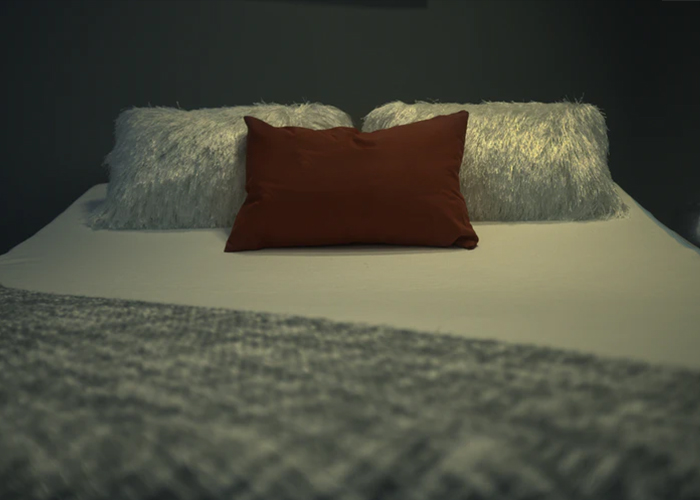
1. Dim the lights
As the sun goes down, dim the lights in your home to signal to body and mind that the pace of the day’s activities is coming to an end—and that it’s time to stop being “on.” Minimize screen time on your electronic devices for at least an hour before bed. Wind down by reading something uplifting or spending time with your family or friends.
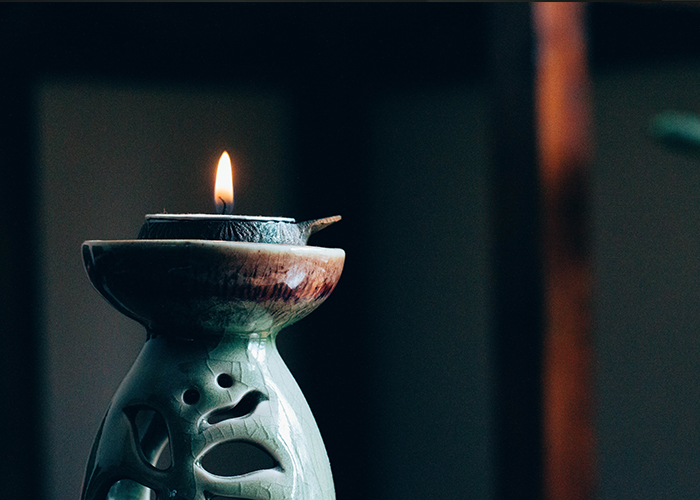
2. Diffuse the oils
Add a few drops essential oils, in your essential oil diffuser. Some commonly used essential oils are lavender, chamomile, frankincense, neroli to soothe your nervous system and prepare your body and mind for sleep.
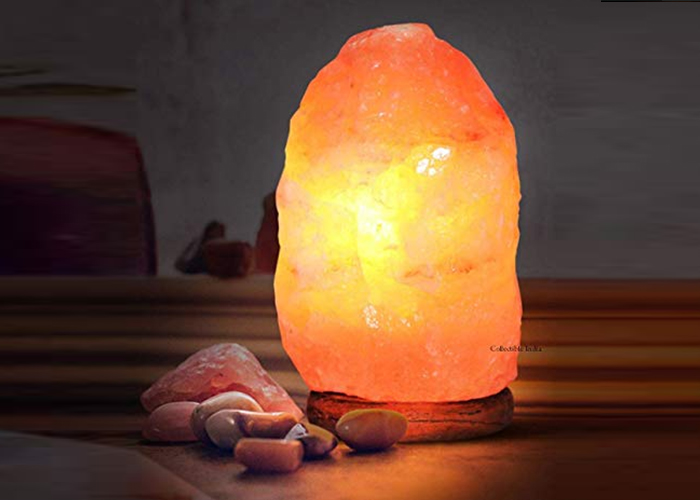
3. Himalayan Salt Lamp
Pink Himalayan sea salt lights make great night-lights . Using the dim light from a Himalayan salt lamp may help promote sleepiness toward the end of the day if you use it to replace bright electric lights. This is because bright light before bed can delay production of the sleep hormone melatonin

4. Massage your feet
“There are several marma points, or Ayurvedic pressure points, on the foot that correspond to the entire body,”. “Doing a foot massage, you can relax the entire body in just a few minutes.”

5. Savor
Before bed, heat a cup of organic whole milk until it boils. Add a pinch of ground cardamom, nutmeg (spices that, in Ayurveda, are said to promote sleep), and cinnamon (to aid digestion). Let it cool a bit and add honey to taste. Warm whole milk is used in Ayurveda as an insomnia remedy. Don’t drink milk? Sip chamomile, valerian, or lemon balm tea.

6. Breathe
To calm yourself for sleep, or before you sit for evening meditation, spend a few minutes doing Nadi Shodhana (also known as alternate nostril breathing). This cleansing breath practice calms the nervous system and, on a more subtle level, opens and balances the sushumna nadi, an energy channel that quiets and steadies the mind.
